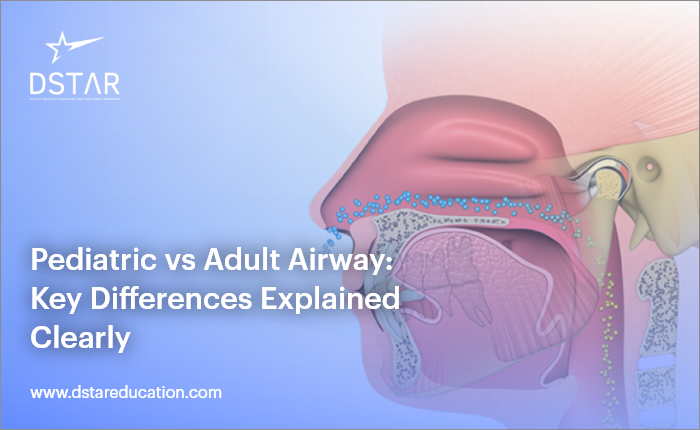Understanding the differences between the pediatric airway and the adult airway is essential for any provider managing sedation or anesthesia. These anatomical and physiological distinctions have a direct impact on airway safety, ventilation techniques, and drug administration during dental and medical procedures. In Texas, mastering these variations is also a requirement for sedation permit training under the Texas State Board of Dental Examiners (TSBDE).
This article explores the pediatric vs adult airway in detail, explaining key differences in structure, physiology, and clinical management. It also outlines why these differences are central to pediatric vs adult airway anesthesia education and DSTAR’s airway-focused continuing education programs.
Pediatric Airway Anatomy Overview
The pediatric airway anatomy is not a smaller version of the adult airway; it is anatomically and physiologically distinct. In an infant or small child’s airway, several characteristics make it more susceptible to obstruction and airway collapse during sedation or anesthesia.
Key features include:
- A proportionally larger head and occiput, causing natural neck flexion when supine.
- A relatively larger tongue in relation to the oral cavity reduces space for instrumentation.
- A higher and more anterior larynx (C3–C4 in infants vs C4–C5 in adults).
- A funnel-shaped subglottic region, with the narrowest part of the pediatric airway at the cricoid cartilage rather than the vocal cords.
- Softer airway cartilage increases susceptibility to dynamic collapse under negative pressure.
Each of these features must be considered during pediatric airway management, especially when selecting airway adjuncts or performing intubation.
Adult Airway Anatomy Overview
By contrast, the adult airway demonstrates more stable structural support. The tongue occupies less relative space in the oral cavity, the epiglottis is thinner and more flexible, and the larynx sits lower in the neck. The narrowest part of the airway in adults lies at the vocal cords, unlike the cricoid ring in children.
The adult trachea also contains firmer cartilaginous rings, reducing the risk of collapse during negative pressure ventilation. These differences are crucial during pediatric vs adult airway anesthesia, as equipment, drug dosage, and airway positioning must be adapted to the patient’s developmental anatomy.
Narrowest Part of the Pediatric Airway
One of the most important distinctions in pediatric vs adult airway anatomy is the location of its narrowest portion. In adults, the vocal cords represent the tightest space, while in infants, the cricoid cartilage forms the narrowest part of the pediatric airway.
This anatomical difference influences endotracheal tube (ETT) selection and technique. Historically, uncuffed tubes were preferred in children to avoid cricoid pressure injury. However, modern low-pressure cuffed tubes are now widely used when carefully managed, providing better control of ventilation and reducing gas leaks.
Additionally, an infant or small child’s airway is more reactive to stimuli, increasing the likelihood of laryngospasm or airway edema. The airway mucosa in infants is thinner and more vascular, making even minor trauma clinically significant.
Understanding the Pediatric airway anatomy in relation to this region is critical for avoiding airway trauma and post-extubation complications.
Clinical Implications for Airway Management
Differences in airway diameter, shape, and position affect every phase of sedation and anesthesia management. During dental sedation, a child’s airway can be compromised by simple factors, such as tongue displacement, neck flexion, or excessive sedative dosing.
Pediatric airway management demands precise head positioning (the sniffing position is modified for infants) and gentle jaw thrust maneuvers to maintain patency. Dentists must be trained to anticipate obstruction and have age-appropriate airway devices immediately available, including oral and nasal airways, supraglottic devices, and bag-valve masks sized for infants and children.
Pediatric vs Adult Airway Anesthesia Considerations
Administering anesthesia to infants or children introduces unique challenges related to pediatric airway anatomy and physiology. In pediatric vs adult airway anesthesia, providers must recognize that children’s airways are more prone to obstruction and rapid desaturation.
Ventilation management differs significantly. Infants have compliant chest walls and depend heavily on diaphragmatic movement. Excessive positive pressure can lead to gastric insufflation or barotrauma. Moreover, dosing of sedatives and anesthetics must reflect immature hepatic metabolism and increased sensitivity to respiratory depressants.
Airway Management Challenges in Pediatrics
Airway management in children is delicate. Unlike adults, even minor obstructions can quickly cause desaturation due to a smaller airway diameter and higher oxygen demand. According to Poiseuille’s law, airway resistance is inversely proportional to the fourth power of the airway radius.
Even a minor decrease in an infant or small child’s airway diameter can therefore cause a dramatic rise in resistance, potentially 16 times greater if the radius is reduced by half, making obstruction rapidly life-threatening. Increased resistance causes increased work of breathing and rapid fatigue.
During sedation, pediatric patients are more prone to laryngospasm, bronchospasm, and airway collapse. Additionally, anatomical differences, such as a floppy, omega-shaped epiglottis, complicate visualization during laryngoscopy.
Understanding these nuances is essential for dental professionals managing sedation under Texas permits.
Preparation Strategies
- Always assess airway anatomy, tonsil size, and neck mobility before sedation.
- Choose equipment (ETTs, LMAs, masks) by weight and age, not “one-size-fits-all.”
- Ensure suction, oxygen, and backup airway devices are immediately available.
- For deep sedation, have a trained assistant capable of managing the infant’s airway during emergencies.
Knowledge of pediatric airway anatomy allows clinicians to anticipate complications and intervene early, before desaturation or cardiac compromise occurs.
Pediatric vs Adult Airway: Respiratory System Differences
Beyond anatomy, respiratory system differences play a vital role in sedation safety. Pediatric lungs have less alveoli, resulting in less surface area for gas exchange. Additionally, the compliant chest wall causes greater work of breathing under stress.
Infants rely on diaphragmatic breathing, and even mild abdominal distension (from crying, sedation, or positioning) can impede ventilation. Unlike adults, they cannot increase tidal volume efficiently; instead, they raise their respiratory rate to meet oxygen needs.
These physiological characteristics require continuous monitoring, pulse oximetry, capnography, and precordial stethoscopes during pediatric sedation. Recognizing early hypoventilation prevents escalation into critical airway events.
Key Safety Protocols for Pediatric airway management
Safety during pediatric sedation relies on three pillars: preparation, vigilance, and training. Dentists and anesthetic providers must incorporate safety checks before every procedure to minimize airway risks.
Recommended Safety Measures
- Conduct a comprehensive airway assessment, including Mallampati score and neck mobility.
- Confirm recent illnesses, allergies, and potential airway swelling.
- Have weight-specific airway and resuscitation equipment ready.
- Continuously monitor oxygen saturation and capnography.
- Review emergency drugs and ensure unexpired supplies are available.
- Maintain PALS (Pediatric Advanced Life Support) certification as required for sedation permit renewal in Texas.
These steps transform theoretical knowledge of pediatric airway anatomy into effective, real-world clinical practice.
Ongoing Education and CE Requirements
The TSBDE mandates that dentists providing sedation complete continuing education in airway management, emergency preparedness, and pharmacology. Providers managing the pediatric airway must also demonstrate PALS certification.
Programs like DSTAR’s sedation CE courses go beyond compliance; they focus on real-world clinical readiness. Understanding pediatric vs adult airway differences helps providers meet CE requirements and strengthen their response to pediatric airway complications.
FAQs
1. What is the difference between the adult and the pediatric airway?
The pediatric airway is smaller, more flexible, and funnel-shaped, with the narrowest part located at the cricoid cartilage. The adult airway is cylindrical, with the narrowest point at the vocal cords.
2. Which of the following is the difference between a pediatric airway and an adult airway?
Children have a proportionally larger tongue, higher larynx, and softer airway cartilage, while adults have firmer airway structures and a lower larynx position.
3. What are the differences between children and adults in the respiratory system?
Children have a higher respiratory rate, smaller lung capacity, and limited oxygen reserves, making them more prone to rapid desaturation during apnea.
4. What is the difference between an adult and a pediatric laryngoscope?
Pediatric laryngoscopes (often straight blades) are designed to lift the floppy epiglottis directly, while adult blades (curved) lift it indirectly through the vallecula.
5. What is the difference between adult and Pediatric patients’ pulmonary anatomy?
Adults have matured airway anatomy and respiratory mechanics, while pediatric patients exhibit smaller, more reactive airways requiring specialized monitoring and technique.
6. How do pediatric laryngoscope blades differ?
Pediatric blades are shorter, narrower, and straight to accommodate the child’s larger epiglottis and higher laryngeal position. However, pediatric curved blades can be used as well.
Conclusion
The pediatric vs adult airway comparison underscores how developmental anatomy shapes clinical management. For dentists and anesthesiologists, recognizing differences in airway anatomy, physiology, and equipment sizing is essential for patient safety during sedation and anesthesia.
Mastering the pediatric airway, from understanding the narrowest part of the pediatric airway to anticipating airway collapse in an infant or small child’s airway, ensures safe, compliant, and effective sedation care. Ongoing continuing education for dentists through accredited programs such as DSTAR helps reinforce these competencies, aligning with both professional and regulatory standards.
References
- American Academy of Pediatric Dentistry. (2023). Guidelines for monitoring and management of pediatric patients during and after sedation for diagnostic and therapeutic procedures. Retrieved from https://www.aapd.org
- American Dental Association. (2023). Guidelines for the use of sedation and general anesthesia by dentists. Retrieved from https://www.ada.org
- American Heart Association. (2024). Pediatric Advanced Life Support (PALS) Provider Manual. Retrieved from https://www.heart.org
- Texas State Board of Dental Examiners. (2024). Sedation and anesthesia permit requirements. Retrieved from https://tsbde.texas.gov
 Take Free TSBDE Anesthesia Jurisprudence Practice Exam Now!
Take Free TSBDE Anesthesia Jurisprudence Practice Exam Now!












